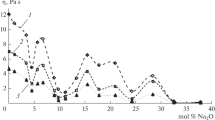Abstract
An equation which is able to describe the temperature dependence of the viscous flow of glassforming melts in a broad range, including the glass-transition range and elevated temperatures has been obtained. The equation contains three parameters; one of them is the preexponential multiplier, which is defined by the extension of the viscosity curve to elevated temperatures (using the Lagrange polynomial), and the other two, the delocalization energy of the atom and the transition potential of the particle, are adjustable parameters. The delocalization energy of the atom that is determined by adjustment is in sufficient accordance with the calculation according to the model of delocalized atoms. The nature of the viscous flow of glass and its melts is discussed.
Similar content being viewed by others
References
Glasstone, S., Laidler, K.J., and Eyring, H., The Theory of Rate Processes: The Kinetics of Chemical Reactions, Viscosity, Diffusion and Electrochemical Phenomena, New York: McGraw-Hill, 1941.
Nemilov, S.V., Valence-configuration theory of viscous flow of supercooled glass-forming liquids and its experimental study, Fiz. Khim. Stekla, 1978, vol. 4, no. 2, pp. 129–148.
Nemilov, S.V., The nature of the viscous flow of the glass with the frozen structure and some investigations of valence configuration flow theory, Fiz. Khim. Stekla, 1978, vol. 4, no. 6, pp. 662–674.
Nemilov, S.V., Viscous flow of glass due to their structure. Application of the theory of velocity growth process, Fiz. Khim. Stekla, 1992, vol. 18, no. 1, pp. 3–44.
Nemilov, S.V., Thermodynamic and Kinetic Aspects of the Vitreous State, Boca Raton, FL: CRC Press, 1995, ch.6.
Sanditov, D.S., On the theory of molecular mobility in liquids and glasses in a wide range of temperature and pressure, Izv. Vyssh. Uchebn. Zaved., Fiz., 1971, no. 2, pp. 18–23.
Sanditov, D.S., Shear viscosity of glass-forming melts in the liquid–glass transition region, J. Exp. Theor. Phys., 2010, vol. 110, no. 4, pp. 675–688.
Sanditov, D.S., Model of viscous flow of glass-forming liquids and glasses, Dokl. Phys. Chem., 2013, vol. 451, no. 2, pp. 178–191.
Sanditov, D.S., Deformation-activation model of viscous flow of glass-forming liquids, J. Non-Cryst. Solids, 2014, vol. 400, pp. 12–20.
Frenkel’, Ya.I., Relation between the different theories of viscosity of liquids, in Soveshchanie po vyazkosti zhidkostei i kolloidnykh rastvorov (Meeting on Viscosity of Fluids and Colloids), Leningrad: Akad. Nauk SSSR, 1944, vol. 2, pp. 24–29.
Macedo, P.B. and Litovitz, T.A., On the relative role of free volume and activation energy in the viscosity of liquids, J. Chem. Phys., 1965, vol. 42, no. 1, pp. 245–256.
Sanditov, D.S., Model of delocalized atoms in the physics of the vitreous state, J. Exp. Theor. Phys., 2012, vol. 115, no. 1, pp. 112–124.
Sanditov, D.S. and Badmaev, S.S., Delocalization of the atom in glass and its liquids, Glass Phys. Chem., 2015, vol. 40, no. 5, pp. 460–466.
Sanditov, D.S., The excited state model and an elementary act of softening of glassy solids, J. Exp. Theor. Phys., 2009, vol. 108, no. 1, pp. 98–110.
Frenkel’, Ya.I., Kineticheskaya teoriya zhidkostei (Kinetic Theory of Liquids), Moscow: Nauka, 1975.
Sanditov, D.S. and Bartenev, G.M., Fizicheskie svoistva neuporyadochennykh struktur (Physical Properties of Disordered Structures), Novosibirsk: Nauka, 1982.
Kumar, S., Viscosity and free volume of fused borates and silicates, Phys. Chem. Glasses, 1963, vol. 4, no. 3, pp. 106–111.
Sanditov, D.S. and Mashanov, A.A., Mathematical treatment of experimental data on the viscosity of glass melts in a wide temperature range, Glass Phys. Chem., 2010, vol. 36, no. 1, pp. 41–44.
MDL® SciGlass-7.8. Institute of Theoretical Chemistry, Shrewsbury, MA, 2012. www.sciglass.info
Myuller, R.L., The valence theory of viscosity and yield stress in the critical temperature range for refractory glass-forming substances, Zh. Prikl. Khim., 1955, vol. 28, no. 10, pp. 1077–1082.
Author information
Authors and Affiliations
Corresponding author
Additional information
Original Russian Text © D.S. Sanditov, S.B. Munkueva, 2016, published in Fizika i Khimiya Stekla.
Rights and permissions
About this article
Cite this article
Sanditov, D.S., Munkueva, S.B. Temperature dependence of the viscous flow of glass-forming melts in a broad temperature range. Glass Phys Chem 42, 135–140 (2016). https://doi.org/10.1134/S1087659616020140
Received:
Published:
Issue Date:
DOI: https://doi.org/10.1134/S1087659616020140




